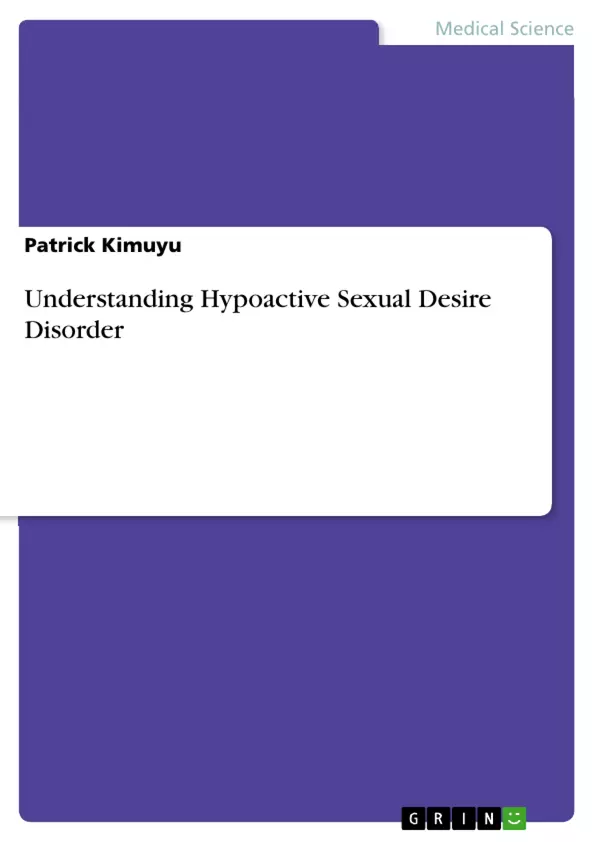In retrospect, sexual disorders have a significant impact on an individual’s quality of life. It is also apparent that these disorders bear immense significance to the clinical practice. Despite their impact, most physicians do not seem to be interested to engage in extensive discussion with patients regarding sexual desire problems. This phenomenon is, probably, attributable to several reasons including time constraints, lack of efficient therapeutic interventions and insufficient knowledge. One of the most debilitating sexual desire disorders is hypoactive sexual desire disorder. HSDD is also known as inhibited sexual desire. HSDD is characterized by decreased or absence of desire for sexual activity and sexual fantasies which causes interpersonal difficulties, as well as personal distress. In some circumstances, the diagnosis of HSDD exhibits co-morbidity to an underlying sexual dysfunction. However, this disorder is not exclusively attributed to the effects of any substance, pathology or another psychiatric disorder. Even though some clinical experts have hypothesized the causes of HSDD to be associated with biological imbalances, the pathophysiology of this disorder remains unknown. As such, efforts to develop a comprehensive treatment and management strategies have not achieved remarkable success. Therefore, this literature review aims at providing an overview of HSDD.
Inhaltsverzeichnis (Table of Contents)
- Introduction
- Epidemiology
- History of HSDD
- Etiology of HSDD
- Low Testosterone
- Low Estrogen
Zielsetzung und Themenschwerpunkte (Objectives and Key Themes)
This literature review aims to provide a comprehensive overview of Hypoactive Sexual Desire Disorder (HSDD), also known as inhibited sexual desire (ISD). The review focuses on the disorder's epidemiology, historical development, and etiology, exploring the interplay of psychological, neurological, and hormonal factors.
- Prevalence and Gender Differences in HSDD
- Historical Development of HSDD Diagnosis and Classification
- Multifactorial Etiology of HSDD
- Role of Hormonal Imbalances in HSDD, particularly Low Testosterone and Low Estrogen
- Impact of HSDD on Individual and Interpersonal Well-being
Zusammenfassung der Kapitel (Chapter Summaries)
- Introduction: The introduction highlights the significant impact of sexual disorders on quality of life and clinical practice. It defines HSDD and its characteristics, emphasizing the lack of comprehensive treatment strategies due to the unknown pathophysiology.
- Epidemiology: This section explores the prevalence of HSDD, noting the higher incidence among women compared to men. It discusses age-related trends in HSDD prevalence, with middle-aged women exhibiting the highest rates.
- History of HSDD: The historical development of HSDD is traced from its early recognition as impotence and frigidity to its inclusion in the Diagnostic and Statistical Manual of Mental Disorders (DSM). The evolution of the definition and classification of HSDD is outlined, highlighting the impact of cultural differences on its perception.
- Etiology of HSDD: This chapter delves into the multifactorial etiology of HSDD, acknowledging the complex interplay of psychological, neurological, and hormonal factors. It identifies low testosterone and low estrogen as principle causes, discussing their impact on sexual desire and responsiveness.
Schlüsselwörter (Keywords)
Hypoactive Sexual Desire Disorder (HSDD), Inhibited Sexual Desire (ISD), sexual dysfunction, epidemiology, gender differences, prevalence, history, diagnosis, classification, etiology, hormonal imbalances, low testosterone, low estrogen, sexual desire, sexual responsiveness, clinical practice, quality of life.
- Quote paper
- Patrick Kimuyu (Author), 2018, Understanding Hypoactive Sexual Desire Disorder, Munich, GRIN Verlag, https://www.hausarbeiten.de/document/411947


